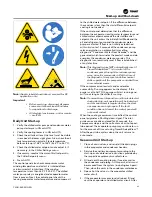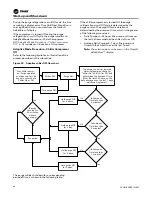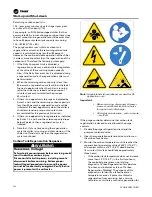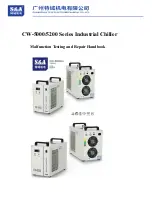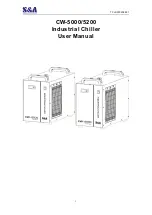
CVHH-SVX001G-EN
101
When sufficient non-condensables have accumulated
in the purge tank to decrease the compressor suction
temperature below the pump-out initiate value, a
pump-out cycle begins. The cycle is terminated when
the compressor suction temperature sensor increases
above the pump-out terminate value. The calculations
for the pump-out values are:
Pump-out initiate:
•
(°F) = Purge liquid temperature (°F) – 50°F, or 0°F
(whichever is higher)
•
(°C) = Purge liquid temperature (°C) – 10.0°C, or
-17.8°C (whichever is higher)
Pump-out terminate:
•
(°F) = Purge liquid temperature (°F) – 40°F, or 5°F
(whichever is higher)
•
(°C) = Purge liquid temperature (°C) – 4.4°C, or -
15.0°C (whichever is higher)
The purge liquid temperature value comes from the
chiller’s saturated condenser temperature sensor when
the chiller is running, or the chiller’s saturated
evaporator temperature sensor when the chiller is off.
Non-condensable Pump-out cycle
A non-condensable pump-out cycle may be initiated as
described below only if the following two conditions
are met:
•
a carbon regeneration cycle is NOT in process, and
•
the refrigeration circuit is on.
If at any time, except as described above, the purge
refrigerant compressor suction temperature drops
below the pump-out initiate value, the following
sequence is initiated by the controls.
The controller starts the pump-out compressor and
opens the exhaust solenoid valve. After 5 seconds, the
pump-out solenoid valve opens and pulses at a rate of
20 seconds On and 20 seconds Off. If after two cycles,
the purge refrigerant compressor suction temperature
has not exceeded the pump-out terminate value, the
pump-out solenoid valve stays continuously open. If
the pump-out compressor runs for more than
10 consecutive minutes, the controller recalculates the
pump-out initiate and pump-out terminate values as
described.
The purge controls continue to operate the pump-out
solenoid valve and calculate values as described above
until the purge refrigerant compressor suction
temperature rises above the pump-out terminate value.
At this point, the controller will close the pump-out
solenoid valve and turn off the pump-out compressor
and exhaust solenoid valve.
N
No
otte
e:: For purge systems equipped with standard
pump-out compressors, operation at low chiller
condenser saturation temperatures may result in
a system vacuum greater than the pump-out
compressor can overcome. If the chiller
experiences low condensing temperatures, then
the Tracer
®
UC800 controller can be
programmed to inhibit the operation of the
purge pump-out compressor.
Carbon Tank and Regeneration
Subsystem
The function of the carbon tank is to absorb refrigerant
molecules that may be entrained in the discharge of
non-condensables. In order to maintain effectiveness,
the carbon tank periodically regenerates.
Carbon Regeneration Algorithm
The controller uses the carbon regeneration algorithm
to determine when to initiate, control, and terminate a
carbon regeneration cycle. The carbon bed
temperature sensor serves as the feedback to this
algorithm. In addition, the controller uses a pump-out
accumulation timer to indicate the remaining carbon
capacity in the carbon tank. The carbon capacity is the
capacity of the carbon to adsorb refrigerant while
maintaining acceptable levels of refrigerant emission
through the chiller vent line. A capacity of 100 percent
means the carbon bed has the capacity to adsorb
refrigerant and maintain acceptable emission levels. A
capacity of 0 percent means the carbon bed has
inadequate capacity to adsorb refrigerant and still
maintain acceptable emission levels.
The main objectives of the carbon regeneration
algorithm are to:
•
Minimize the amount of refrigerant contained in the
carbon by performing a periodic regeneration.
•
Regenerate to maintain low emissions levels.
•
Minimize the regeneration time.
•
Regenerate only when the chiller is at a minimum
level of purging activity.
•
Allow regeneration to occur with the chiller On or
Off. Regeneration is preferable when the chiller is
On to ensure low carbon tank pressure, but
regeneration is also acceptable when the chiller is
Off.
The remaining amount of adsorption capacity within
the carbon tank is directly proportional to the number
of purge pump-out minutes that have accumulated,
and is also a function of the chiller refrigerant type. The
purge carbon tank on an R-1233zd-equipped chiller is
considered to be fully saturated after the purge has
accumulated 350 minutes of pump-out time. Because
the relationship between pump-out capacity and
pump-out minutes is directly proportional, it can be
described by the following equation within the
regeneration algorithm:
Summary of Contents for CVHH CenTraVac
Page 126: ...126 CVHH SVX001G EN N No ot te es s ...









